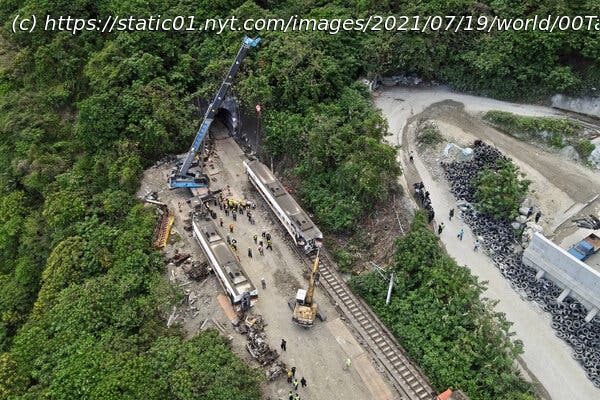A Times investigation found that systemic failures at a government agency contributed to Taiwan’s worst rail disaster in seven decades.
It seemed at first like a freak accident. A contractor was navigating a sharp turn on a sand-packed road. He had been hired to shore up a steep hillside on Taiwan’s east coast — any falling debris could be a safety hazard to the trains that rushed by below. At the edge of the embankment, his truck got stuck. He and another worker tried to pull it free, using a cloth strap and an excavator. The strap snapped, and the truck tumbled down the hill onto the railway tracks. About a minute later, Taroko Express No.408 collided with the truck, killing 49 people and injuring more than 200. In an instant, the picturesque oceanside slope became the site of Taiwan’s deadliest railway disaster in seven decades. The tragedy on that April morning is one of several crises that have shaken this island democracy of 23.5 million people, which prides itself as a well-managed and accountable society. It has undermined confidence in the government at a time when Taiwan has struggled with a surge in coronavirus cases and rolling electrical blackouts. While prosecutors have accused the contractor, Lee Yi-hsiang, and others of negligent homicide, the roots of the disaster go much deeper, revealing systemic failures at the government agency that runs the train system, the Taiwan Railways Administration. A close examination of the crash by The New York Times, based on interviews with current and former officials, railway employees, contractors and safety experts, found that the agency suffered from a culture of complacency and weak oversight. Contractors like Mr. Lee were mismanaged, maintenance problems festered, and officials missed or ignored safety warnings — creating conditions that contributed to the crash. A government adviser told officials in 2017 that the line on which the crash occurred was an accident waiting to happen. Earlier this year, a local worker for the agency twice warned about the risk of heavy equipment maneuvering around that same turn. No one did anything. The authorities are investigating whether the agency should have done more to follow up, Chou Fang-yi, a prosecutor on the case, told The Times. Mr. Lee should never have been awarded the project under the agency’s rules. According to the indictment, he illegally misrepresented his company on the application, using the credentials of a larger, more experienced company to qualify for the project. The agency did not do enough due diligence to uncover the problem. “This accident could have been avoided,” Li Kang, a member of the Taiwan Transportation Safety Board, a government agency investigating the crash, said in an interview. Since the disaster, Taiwan’s president, Tsai Ing-wen, has vowed to address longstanding complaints about the Taiwan Railways Administration, which provided more than 500,000 rides per day before the pandemic. A report by Taiwan’s transportation ministry released on Sunday cited failings in the railway agency’s safety processes and management of construction projects. The railway agency said it was undertaking reforms. In May, it reprimanded 12 employees for “inadequate supervision and management” of the project at the crash site, though none were dismissed. In a written response to questions, the agency said the reprimands were a “warning and a chance for public servants to reflect on their failure to properly fulfill their duties.” Past promises to improve have had little result. Ms. Tsai’s government called for reforms in 2018 after a train crash in the northeast killed 18 people. Although some recommendations were instituted, structural changes were not. Since 2012, the agency’s trains have experienced 316 major incidents, including collisions and derailments, according to a review by The Times of data from Taiwan’s transportation ministry. The accidents have killed 437 people. By comparison, Taiwan High Speed Rail, the newer, public-private high-speed system on the island’s west coast, had no major incidents during the same period. “Typically when there is an accident, T.






